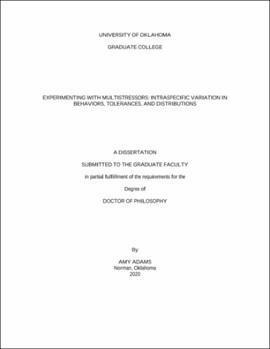| dc.description.abstract | Understanding organisms’ behavioral, spatial, and physiological responses to stress is critically important for successfully predicting and managing population declines and extinctions. Currently, climate change is accelerating and exacerbating stressors such as heat and desiccation into ecosystems across the globe. A key ecological priority is to determine how organisms respond when these stressors interact with abiotic and biotic stressors already present within ecosystems. Traditionally, intraspecific variation in multistressor responses has been neglected in experimental work and population models. In my dissertation, I adopted experimental and meta-analytic approaches to determine how multiple stressors combine to shape intraspecific behaviors, tolerances, and distributions.
In Chapter 1, I focus on the nesting behavior of the social insect herbivore Hyphantria cunea in different host tree taxa, with special attention to their vertical distribution because this is often neglected in ecological assessment and management strategies. In the field, I measured larval nest placement and abundance in tree crowns along with microclimatic variables to determine if the probability of nesting lower in the crown differed from the probability of nesting higher in the crown. I found that there was a low probability of nesting higher in a tree crown, and that this pattern could be attributed to host plant taxonomy. I then ran a laboratory feeding experiment to determine if insect dietary stress was the main driver of this nesting pattern, or if alternative ecological factors were the cause. In the feeding experiment, larval mass and mortality on a diet of upper crown leaves was compared to a diet of lower crown leaves for two common host taxa, and one host taxon is characteristically more toxic than the other. For both plant taxa, lower crown leaves led to greater H. cunea larval mass and survival, indicating that dietary stress plays a key role in this insect’s vertical distribution. I conclude that population modeling and management can improve by accounting for vertical distribution patterns and how biotic stress shapes these patterns.
In Chapter 2, I explored how combining dietary and climate stress affected H. cunea mass and mortality, and if stress tolerances were locally adapted. I ran a multifactorial common garden experiment with insects extracted from low, moderate, and high rainfall locations in Oklahoma, USA, to test the following hypotheses: 1) there is a stress tolerance trade-off according to Shelford’s law of tolerance, which reduces mass and survival when stress is combined 2) there is no stress tolerance trade-off; cross-talk or cross-tolerance should increase mass and survival when stress is combined and 3) local adaptation modulates relationships between stress tolerances. Larval mass and mortality were compared across treatments featuring various levels of dryness, heat, and plant toxicity. Modality of response to multiple stressors differed based on source population. H. cunea from low and moderate rainfall locations tolerated plant chemical stress well as the landscape becomes drier and warmer, while populations from high rainfall locations tolerated plant chemical stress well as conditions become warmer only if they are not simultaneously water stressed. It is essential to account for multistressor effects and intraspecific variation in these effects to accurately predict which populations will respond to environmental changes positively, neutrally, or negatively.
In Chapter 3, I continued to assess for local adaptation in H. cunea stress responses, but this time I focused on behavioral interactions instead of physiological tolerances. I used a common garden experiment with insects extracted from low, moderate, and high rainfall locations in Oklahoma, USA, to test the following: 1) According to the Stress Gradient Hypothesis, stress increases the probability of cooperative behavior regardless of the genetic relatedness of individuals, and 2) According to Hamilton’s rule of kin selection, genetic relatedness increases the probability of cooperative behavior. Water availability and plant diet were manipulated to introduce stress in this study, and behaviors were compared between siblings that were familiar with each other, siblings that were not familiar with each other, and non-siblings. The behaviors investigated included larval predator defense and adult eclosion and inbreeding. Stress increased the probability of cooperative behavior, as did kin relatedness. Behaviors were locally adapted such that H. cunea from higher rainfall locations were more selfish as adults and used more water to defend themselves as larvae. The regional variation we detected in this study indicates that climate change should influence evolution by decreasing selfishness regardless of kin relatedness.
In Chapter 4, I used a meta-analytic approach to determine if the theme of stress shifting organism interactions positively extended beyond H. cunea. This is the first systematic review and specifically the first meta-analysis to address if this pattern is more common in intraspecific or interspecific interactions, and particular kingdoms, ecosystems, habitats, life history stages, response variables, and stressors. The pattern of positive interactions increasing with increasing stress is well supported by studies that feature bacteria, plants, terrestrial ecosystems, interspecific negative interactions, adults, survival instead of growth or reproduction, and drought, fire, and nutrient stress. This review reinforces the novelty of my previous work with H. cunea because it shows experimental studies featuring multistressor responses are relatively scarce, and usually intraspecific interactions shift negatively instead of positively. | en_US |
